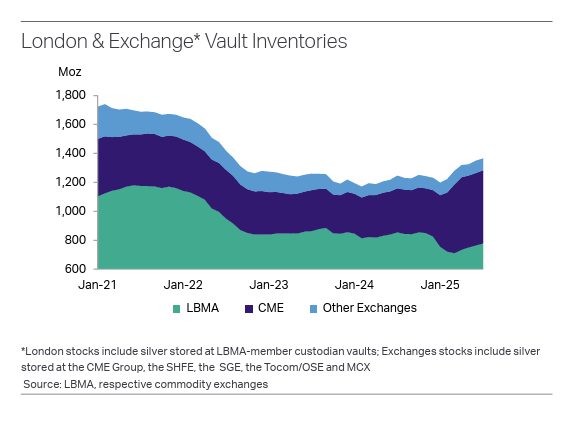In the latest Money Metals Midweek Memo, host Mike Maharrey tackles the most frequently asked questions from investors, precious metals enthusiasts, and citizens concerned about the state of the economy.
This episode functions as a deep-dive AMA (Ask Me Anything), unpacking the implications of gold’s historic surge, silver’s sluggish response, storage strategies, de-dollarization, digital currencies, and the often-missed mechanics behind inflation and monetary policy.
Gold Blasts Through $3,100 — Fastest Run in Modern History
Gold has reached a new all-time high, trading above $3,100 per ounce just two weeks after first crossing the $3,000 threshold on March 14, 2025. Maharrey noted that this surge is historically fast.
Gold jumped from $2,500 to $3,000 in just 210 days, a stark contrast to the historical average of 1,700 days to gain $500 in price. He attributes this meteoric rise to a “perfect storm” of macroeconomic pressures, including de-dollarization, persistent inflation, recession worries, and uncertainty around trade and tariffs.
While the speed of the rally surprised him, he emphasized that the underlying fundamentals remain strong. However, he cautioned that corrections are inevitable in any bull market.
Why Is Silver Lagging Behind?
Despite gold’s breakout, silver has failed to keep pace. While it has seen moderate gains, it remains significantly undervalued when compared to gold. The gold-to-silver ratio has widened again, reaching around 91 or 92 to 1. This is a strong historical indicator that silver is underpriced.
Maharrey believes part of the reason is the smaller size of the silver market, which makes it easier for large financial institutions to suppress prices through futures and short positions.
Still, he points out that silver traditionally lags in early-stage gold bull markets before catching up dramatically. With tight supply and increasing industrial demand, he views this as a strategic buying opportunity for long-term investors.
Physical vs. Vaulted vs. ETF: Where Should You Store Gold?
On the topic of gold storage, Maharrey outlines three primary options: keeping gold at home, using a bullion depository, or investing through exchange-traded funds (ETFs). He acknowledges the appeal of holding physical gold due to its lack of counterparty risk. However, he warns that home storage comes with its own risks, including theft.
Depository storage introduces some level of counterparty risk, but reputable facilities like the Money Metals Depository in Idaho offer layered security and regular audits to mitigate those concerns.
ETFs, on the other hand, offer exposure to gold’s price movement without physical ownership. While convenient and liquid, ETFs carry significant counterparty risk and should be considered a supplemental investment—not a replacement for owning physical metal.
Fort Knox: Is the Gold Really There?
Addressing the popular question about Fort Knox, Maharrey said he believes the gold is probably physically present but expressed doubts about how much of it is encumbered through leases or other paper claims. He criticized the lack of a full, transparent audit process.
While government officials often say audits occur, they typically only inspect seals placed on vault doors years ago, rather than verifying the actual gold holdings. Maharrey stressed the need for ongoing internal and external audits, noting that this is standard practice at private vaults like the Money Metals Depository.
Will the Dollar Collapse?
When asked whether the dollar will collapse, Maharrey clarified that he doesn’t anticipate a sudden cataclysmic event.
Rather, he expects a continued erosion of the dollar’s global influence. The ongoing shift toward de-dollarization, especially among BRICS nations, is already reducing global demand for the dollar. This demand has historically enabled U.S. government borrowing and money creation without immediate inflationary consequences.
Central banks have accelerated this shift by purchasing over 1,000 tons of gold annually for the last three years—more than double the previous average. Maharrey foresees a multipolar reserve system featuring euros, yuan, gold, and potentially even crypto.
The slow death of dollar dominance, while less dramatic than a collapse, could still trigger major inflation and economic instability in the U.S.
CBDCs: A Two-Pronged Rollout
Maharrey predicts that two forms of central bank digital currencies (CBDCs) are developing along different timelines.
Wholesale CBDCs—used for international trade and cross-border settlements—are already taking shape and are expected to be implemented more quickly. These will allow countries like Russia and China to bypass the U.S. dollar in trade, a significant step in de-dollarization.
Retail CBDCs, intended for everyday consumer use, are likely to take longer due to widespread political and social resistance in the U.S. Many states are already drafting legislation to block them.
Maharrey warned that a future crisis could be used as a pretext for a rapid rollout of a digital dollar, pointing to past examples like the Patriot Act following 9/11.
Gold vs. Silver: Why Not Both?
When asked whether investors should focus on gold or silver, Maharrey’s answer was straightforward: both. He advocates for diversification, explaining that gold is a long-term store of wealth, while silver serves as a more practical tool for everyday transactions—especially in crisis scenarios.
Silver’s lower price point makes it more accessible to new investors, particularly with the current gold-to-silver ratio signaling that silver is undervalued.
He also highlighted Money Metals’ monthly purchase plan, which allows individuals to build a gold and silver portfolio over time with as little as $100 per month.
Economic Blind Spots: What the Mainstream Misses
One of Maharrey’s key frustrations with mainstream economic discourse is the failure to account for unseen consequences of government policy. He referenced the French economist Frédéric Bastiat, who stressed the importance of evaluating both seen and unseen effects.
Policies like minimum wage laws and tariffs may appear beneficial on the surface, but they often carry significant hidden costs, such as job losses or higher prices. Maharrey also emphasized the central role of the Federal Reserve and monetary policy in driving inflation, noting that fiscal policies from the White House are secondary to the Fed’s control over money supply and interest rates. He urged listeners to deepen their understanding of the business cycle and central banking to grasp the full picture.
Final Thoughts
Maharrey closed the episode by encouraging listeners to speak with a Money Metals specialist for guidance on investing in precious metals, storage options, and the monthly savings program.
1-800-800-1865
He emphasized that owning physical gold and silver is a vital foundation for wealth preservation.
Listeners can explore more at MoneyMetals.com/news or subscribe to the Midweek Memo and Market Wrap podcasts for ongoing insights. As always, he reminded his audience that sharing the podcast and leaving reviews helps expand the reach of sound money education.
Read the full article here







Leave a Reply